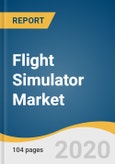The global flight simulator market size is expected to reach USD 6.4 billion by 2027, expanding at a revenue-based CAGR of 4.2%. Increasing adoption of Full Flight Simulator (FFS) owing to high fidelity and reliability is expected to provide adequate growth prospects over the coming years. Customers also opt for fixed Flight Training Devices (FTDs) on account of their low operational costs, modular approach, real-time aerodynamic aviation model, and remote configuration and management. The industry is expected to witness moderate growth over the forecast period owing to the aforementioned factors.
The market is poised for growth owing to advances in aircraft simulation technology which is expected to change the pilot training. The need to effectively replicate real flying training with the usage of motion and visual systems has resulted in the introduction of sophisticated simulators in the flight simulators market. Increase in government spending and growing security concerns particularly in the military sector is anticipated to escalate product demand significantly. The rising concerns over pilot training cost along with fluctuating fuel prices may further drive the market over the next eight years.
The design of aircraft simulators is based on original cockpit of respective aircraft models. Companies like Lufthansa Aviation Training offer simulators with cockpit designs from aircraft manufacturers like Airbus S.A.S, Boeing, Bombardier, and Embraer. The company provides simulators with navigation trainer, which imparts practical instrument training by replicating different weather and environmental conditions. Technological advancements have significantly resulted in motion systems being converted from hydraulic to electric for improved fidelity and smoothness. Additionally, advancements such as the onset of advanced visual systems that offer more than 180-degree view in satellite quality of all important objects at the relevant airport is also anticipated to provide growth prospects in this industry.
Further key findings from the report suggest:
This product will be delivered within 1-3 business days.
The market is poised for growth owing to advances in aircraft simulation technology which is expected to change the pilot training. The need to effectively replicate real flying training with the usage of motion and visual systems has resulted in the introduction of sophisticated simulators in the flight simulators market. Increase in government spending and growing security concerns particularly in the military sector is anticipated to escalate product demand significantly. The rising concerns over pilot training cost along with fluctuating fuel prices may further drive the market over the next eight years.
The design of aircraft simulators is based on original cockpit of respective aircraft models. Companies like Lufthansa Aviation Training offer simulators with cockpit designs from aircraft manufacturers like Airbus S.A.S, Boeing, Bombardier, and Embraer. The company provides simulators with navigation trainer, which imparts practical instrument training by replicating different weather and environmental conditions. Technological advancements have significantly resulted in motion systems being converted from hydraulic to electric for improved fidelity and smoothness. Additionally, advancements such as the onset of advanced visual systems that offer more than 180-degree view in satellite quality of all important objects at the relevant airport is also anticipated to provide growth prospects in this industry.
Further key findings from the report suggest:
- The FFS product segment accounted for over 90% of the overall revenue in 2019 and is expected to witness a revenue-based CAGR of 4.6% during the forecast period. This growth is owing to features that provide motion, sound, visuals, and all other aircraft operations that create a realistic aviation training environment
- The demand in civil application segment is primarily due to the rising air traffic coupled with the growing emphasis on the passenger as well as pilot safety. Governments in several countries have enforced strict regulations regarding the use and significance of simulation training
- Europe accounted for more than 30% of the overall market share in 2019 and is expected to exhibit a modest growth over the next eight years on account of the elevating enforcement of regulations pertaining to pilot training and passenger safety
- In Asia Pacific, the flight simulator market is estimated to exhibit a substantial growth over the forecast period in light of the growing aviation industry, resulting in the increasing demand for aircraft simulators. Middle East and Africa is also projected to showcase a substantial demand of over 5%, which is primarily be attributed to the presence of carriers including Emirates, Etihad Airways, and Qatar that are investing heavily in this industry
- Prominent industry players include CAE, Boeing, L-3 Link Simulation and Training, Lockheed Martin, Rockwell Collins, Thales and Saab. Industry participants emphasize on joint ventures, mergers, and acquisitions in order to acquire greater financial, technical, marketing, manufacturing, and distribution expertise.
This product will be delivered within 1-3 business days.
Table of Contents
Chapter 1. Methodology and Scope
Chapter 2. Executive Summary
Chapter 3. Flight Simulator Industry Outlook
Chapter 4. Flight Simulator Market: Product Outlook
Chapter 5. Flight Simulator Market: Application Outlook
Chapter 6. Flight Simulator Market: Regional Outlook
Chapter 7. Competitive Analysis
Chapter 8. Competitive Landscape
Companies Mentioned
- Alenia Aeronautica
- Boeing
- CAE
- Cassidian
- DiSTI
- Fidelity Technologies Corporation
- HAVELSAN
- Kratos Defense and Security Solutions
- L-3 Link Simulation and Training
- Lockheed Martin Corporation
- Meggitt Training Systems
- Rockwell Collins
- SaaB
- Sikorsky Aircraft Corporation
- Teledyne Brown Engineering, Inc
- Thales
- VirTra Systems
- ZedaSoft, Inc.
Methodology

LOADING...








